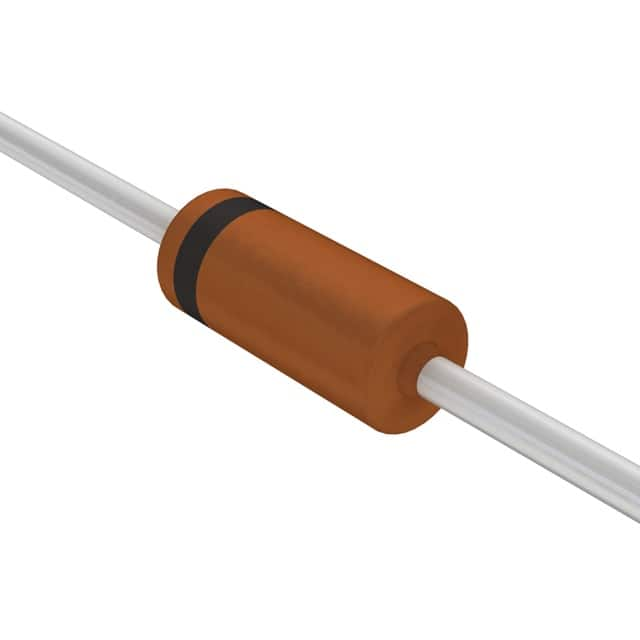Voir les spécifications pour les détails du produit.

BZX79-C51,133
Product Overview
Category
The BZX79-C51,133 belongs to the category of Zener diodes.
Use
It is commonly used for voltage regulation and protection in electronic circuits.
Characteristics
- Zener voltage: 51V
- Power dissipation: 500mW
- Package type: DO-35
- Operating temperature range: -65°C to +200°C
- Storage temperature range: -65°C to +200°C
- Forward voltage: 1.2V
- Reverse current: 5µA
Package
The BZX79-C51,133 is typically available in reels or bulk packaging.
Essence
The essence of the BZX79-C51,133 lies in its ability to maintain a constant voltage across its terminals when operated in the reverse breakdown region.
Packaging/Quantity
It is commonly packaged in reels containing a quantity of 2500 units.
Specifications
- Zener voltage: 51V
- Power dissipation: 500mW
- Maximum forward voltage: 1.2V
- Maximum reverse current: 5µA
- Package type: DO-35
- Operating temperature range: -65°C to +200°C
- Storage temperature range: -65°C to +200°C
Detailed Pin Configuration
The BZX79-C51,133 has two pins and follows the standard pin configuration for Zener diodes.
Functional Features
- Voltage regulation: The BZX79-C51,133 maintains a constant voltage across its terminals when operated in the reverse breakdown region.
- Protection: It protects sensitive components in electronic circuits from voltage spikes and surges.
Advantages
- Precise voltage regulation
- Compact size
- Wide operating temperature range
Disadvantages
- Limited power dissipation capability
- Sensitive to temperature variations
Working Principles
The BZX79-C51,133 operates based on the principle of the Zener effect, where it maintains a nearly constant voltage across its terminals when operated in the reverse breakdown region.
Detailed Application Field Plans
The BZX79-C51,133 finds applications in various electronic circuits, including: - Voltage regulators - Overvoltage protection circuits - Signal clamping circuits - Voltage reference circuits
Detailed and Complete Alternative Models
Some alternative models to the BZX79-C51,133 include: - BZX79-C47,133 (Zener voltage: 47V) - BZX79-C56,133 (Zener voltage: 56V) - BZX79-C62,133 (Zener voltage: 62V)
In conclusion, the BZX79-C51,133 Zener diode offers precise voltage regulation and protection in a compact package, making it suitable for various electronic applications.
Word count: 366
Énumérez 10 questions et réponses courantes liées à l'application de BZX79-C51,133 dans les solutions techniques
What is the BZX79-C51,133?
- The BZX79-C51,133 is a 51V Zener diode designed for voltage regulation and protection in electronic circuits.
What are the typical applications of BZX79-C51,133?
- It is commonly used in voltage regulation, overvoltage protection, and signal conditioning in various technical solutions.
What is the maximum power dissipation of BZX79-C51,133?
- The maximum power dissipation of BZX79-C51,133 is typically around 500mW.
What is the voltage tolerance of BZX79-C51,133?
- The voltage tolerance of BZX79-C51,133 is typically around ±5%.
What is the operating temperature range of BZX79-C51,133?
- The operating temperature range of BZX79-C51,133 is usually between -65°C to +150°C.
How does BZX79-C51,133 provide overvoltage protection?
- BZX79-C51,133 acts as a voltage clamp, conducting current when the voltage across it exceeds its breakdown voltage, thus protecting downstream components.
Can BZX79-C51,133 be used for voltage reference applications?
- Yes, BZX79-C51,133 can be used as a stable voltage reference due to its well-defined breakdown voltage.
What are the key characteristics of BZX79-C51,133 for circuit design?
- Key characteristics include its breakdown voltage, power dissipation, voltage tolerance, and temperature stability.
Is BZX79-C51,133 suitable for low-power applications?
- Yes, BZX79-C51,133 is suitable for low-power applications due to its moderate power dissipation rating.
Are there any specific layout considerations for using BZX79-C51,133 in a circuit?
- It is important to consider proper heat sinking and placement to ensure the device operates within its specified temperature range and power dissipation limits.

